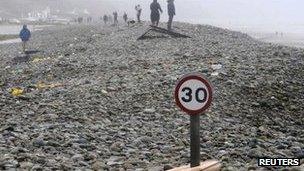Storms uncover ancient trees at Newgale, Pembrokeshire
- Published

The fragile tree remains were revealed after the storms
The remains of 10,000-year-old trees have been uncovered on a Pembrokeshire beach by the recent storms.
The clean-up on the coast park revealed remnants of the ancient woodland at Newgale.
They form part of a forest which experts say would have been used by hunter gatherers.
Elsewhere in Wales the storms have uncovered two Georgian cannon in Porthcawl and a 19th Century bath house in Aberystwyth.
Phil Bennett, heritage manager for Pembrokeshire Coast National Park Authority, said the woodland was an important find.
"We've known of the existence of this forest for many years but I, for one, have never seen it so close to the road," he said.
"The storms and high seas have pushed the pebble bank back and scoured the sand, exposing the remains of this woodland.
"We have been able to identify some recognisable timbers from the Mesolithic [about 11,600 years ago] period.
"Ten thousand years ago this woodland area would have been visited by hunter gatherer bands from time to time, looking for game and collecting edible plants, nuts and berries as these resources became available during the year."
The site was found as work began to clear the road through Newgale which was left covered with debris following the storms.
The local authority is covering some of the exposed trees with pebbles to stop them from drying out the sun.

The main A487 road at Newgale was covered by a mountain of pebbles after the storm
National park archaeologist Pete Crane advised the council restore the pebble bank on top of the remains to help preserve them.
Mr Bennett added: "It's really important that people are aware of how fragile these remains are and understand that unless we protect them they will be gone forever."
In Aberystwyth the remains of a bath house dating back to 1810 was found following the collapse of the town's seafront Victorian shelter.
In Porthcawl two cannon were discovered by dog walkers on Pink Bay, and are believed to date back to 18th Century or the early 19th Century.
The town's museum will now work on preserving the find and carry out research into their history.
- Published13 January 2014
- Published8 February 2011
- Published4 October 2013